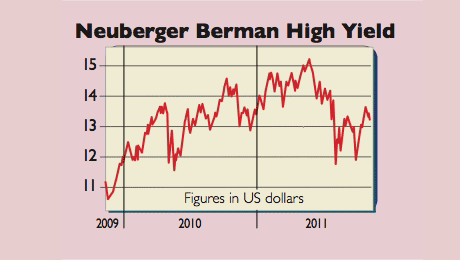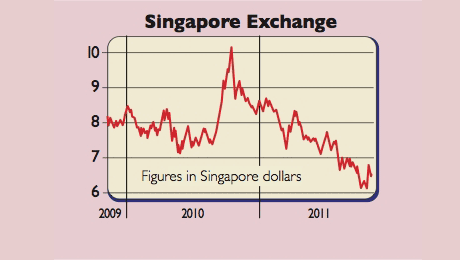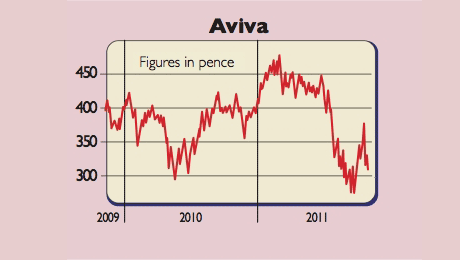Back in October 2010, we looked at some of the best ways to secure an income from your portfolio. Among other options, we came down heavily in favour of buying blue-chip stocks. The investment trusts we tipped back then Edinburgh Investment Trust (LSE: EDIN) and Dunedin Income & Growth Investment Trust (LSE: DIG) have performed reasonably respectably, delivering a total return (ie, including dividends) of 10.9% and 3% respectively during a period when the FTSE All-Share has returned 1.2%. We'd still be happy to hang on to them, along with the other defensive blue-chip shares in your portfolio.
However, with inflation in Britain rising even further since then, it's becoming no easier to protect your wealth the available rates on cash savings are still poor, particularly for higher-rate taxpayers, while traditionally safe' investments, such as gilts and Treasuries, offer minimum yields and look vulnerable to sudden swings in market sentiment.
So if you are open to the idea of adding a bit of spice to your portfolio, we've looked at some alternative options to the usual defensive options. As you'll see, these are all riskier options for investors, but we believe that the higher yields on offer compensate for that.
MoneyWeek
Subscribe to MoneyWeek today and get your first six magazine issues absolutely FREE

Sign up to Money Morning
Don't miss the latest investment and personal finances news, market analysis, plus money-saving tips with our free twice-daily newsletter
Don't miss the latest investment and personal finances news, market analysis, plus money-saving tips with our free twice-daily newsletter
1. Distressed debt
Distressed debt funds are not popular, writes Tim Bennett. Aggrieved politicians and the owners of some of the firms they target accuse them of feeding, vulture-like, on the carcasses of dead, or dying companies. But given the right conditions, they can certainly make big returns. So who buys distressed debt, and how can you profit from it?
The big investors in the sector come in two main types hedge funds and private-equity investors. Both are looking for opportunities that other investors have missed, or at least mispriced. For the hedge funds that usually means buying debt securities in firms that have run into trouble (usually because they have over-borrowed). They take advantage of the fact that other investors tend to sell these high-risk, high-yield bonds as fast as they can when problems arise.
Why? Pure fear of losing all their money should the issuer default, in most instances. For institutional sellers, the reason may be that the paper is at risk of slipping quickly below the investment grade, or prime, minimum quality threshold that they require. This is usually around BBB. Having bought them, later the hedge fund will aim to sell the same securities for a profit.
Private-equity investors, on the other hand, seek out companies that have either gone bust or are about to. By definition this means they can pick up assets cheaply. They will then do one of two things. Either they identify the company's best assets, sell these off for a profit, then liquidate the firm; or, they ruthlessly cut costs, restructure the company they have bought into (in the US, the Chapter 11 bankruptcy rules give a firm a period of respite from its creditors while it is reorganised) and aim to return it to trading.
Typically the firm will end up much smaller staff will have been fired and overheads cut but it should also be in better health. Recent examples of firms that have gone through this process include the failed insurance giant AIG, and US carmaker General Motors.
One common feature of distressed debt buyers is that they tend to buy a firm's bonds rather than its shares. While shareholders legally own a firm, it's the bondholders who usually have the economic clout. Once a firm has borrowed it must keep paying interest on its debts or its bondholders (creditors' in accounting speak) can force restructuring, or even liquidation, on it precisely what some private-equity funds seek to do.
So where are the best opportunities just now? You might think Europe would be the prime area. As Robin Wigglesworth notes in the Financial Times, credit-ratings agency Standard & Poor's reckons that "European companies have to repay more than $4,000bn of loans and bonds in the next four years". That's at a time when their usual source of funding the banks are planning to shrink, not expand, their balance sheets. According to Bloomberg, French, Spanish, Irish, German and British banks have already announced they will try to dump €775bn of assets. So it's little wonder that many distressed debt specialists are "ramping up their European operations".
However, we'd be cautious about plunging in now. As turnaround specialist Wilbur Ross of WL Ross & Co notes, "you can get really hurt if you go in too early". Another reason for caution is that some of Europe's peripheral states have different restructuring and insolvency laws to the US there is no direct European equivalent of Chapter 11, for example.
Then there's price even now, the gulf between what holders of distressed debt are prepared to sell for and what an investor might pay is still wide. Gavin Colquhoun of Deutsche Bank predicts asset sales will be "sluggish". So while Europe is one to keep an eye on, we'd rather stick with a well-established US fund.
One promising-looking option is the Neuberger Berman High Yield Strategies fund (Amex: NHS). This fund has been running since 2003. Rated four stars by research group Morningstar, up to 80% of the fund is invested in sub-investment-grade debt securities, and up to 20% can be in extremely speculative C-rated bonds. The fund's top holding is in American carmaker Ford.

So far this year it is up 6.4% in the year to date, and up 40% over three years. The adjusted expense ratio is 1.32% and the fund trades on a small premium to its net asset value (or NAV). It also pays a yield of 9%.
2. Singaporean blue-chip stocks
If you're looking for income, then there are two good long-term reasons to invest in Singapore, writes Cris Sholto Heaton. Firstly, Singapore has a very strong dividend culture. Firms tend to start paying out relatively early on. Because the market is seen as less of a growth play than most of its neighbours, valuations tend to be lower. So you can find several large, well-run firms offering dividend yields in the 4%-6% range.
Secondly, you are also investing in the Singapore dollar. Of course, there's no guarantee, but we believe that as economic power shifts from West to East, the Singaporean dollar is likely to rise against sterling over time. So even though the dividend yields available on many Singaporean blue-chips are similar to those on UK-listed stocks, you'll get the added kicker of the currency gains (obviously this can go against you too, which is the risk you take when investing overseas).
While the Singaporean market isn't at rock-bottom valuations right now, it still looks reasonable value. The price-to-book ratio is 1.5 compared to a 15-year average of 1.7, while the overall dividend yield of 4.3% compares to an average of 2.8% over the same period.

So what stocks should you consider? The most obvious option is Singapore's largest telecoms group, Singapore Telecommunications (STI: ST). It's the largest stock on the Singapore exchange, and it also has exposure to countries such as Australia, India, Indonesia and Thailand. On a trailing yield of 5%, there should be steady upside for the company's dividend.
In the aerospace and defence area, Singapore Technologies Engineering (STI: STE) is well worth a look. It provides engineering services to military and civilian customers around the world in aviation, electronics, naval and land systems. The stock currently yields 5.1% and growth should be steady, if unexciting.
After a 20% sell-off this year, stock and derivatives exchange operator Singapore Exchange (STI: SGX) looks attractive if you believe that Asian financial markets will continue to grow and that Singapore will remain a major financial centre in the years ahead. The trailing yield for the firm is 4.2%.
For more from Cris, sign up for his free weekly email, MoneyWeek Asia.
3. Financial stocks
If there's one sector that investors hate right now, writes David Stevenson, it's the financial sector. You can understand why. Many lenders' balance sheets contain a whole load of nasties, not encouraging when Europe is on the brink of disaster. But in their haste to avoid dodgy banks, investors are missing a trick. They've sold off insurers along with the rest of the financials. As a result, some solid-looking stocks are now offering very attractive dividend yields for investors who are willing to take just a little more risk.
Why have insurers fallen alongside banks? Firstly, investors are worried that insurers' balance sheets contain the same toxic assets as those of the banks. Insurers have to invest their premiums to make sure they have enough money to cover claims, and the fear is that those investments may not be as solid as they should be, particularly with Europe in the trouble it's in.
Insurers also face similar regulatory problems to the banks. Banks must ensure they have enough capital to comply with the Basel II and Basel III solvency rules. Insurers have their own version of these, called Solvency II. The fear is that insurers might need to raise more capital to meet these rules, which could lead to more shares being issued, diluting existing holders. On top of all that, a spate of natural disasters from Japan to New Zealand have made this an expensive year.
So you can see why investors have been worried. But the latest results from the big insurers suggest that they've been fretting too much. Non-life insurer RSA (LSE: RSA), which my colleague Phil Oakley examines in detail, is now offering a prospective dividend yield of just under 8%, and recent results suggest it can keep this up.
Insurance premiums received from customers were 11% higher in the first nine months of 2011, compared with the same period last year. The profit picture looks good too. Non-life insurers gauge their profits using a measure called the combined ratio'. To get this, you add the cost of claims received to administrative expenses, then divide by premiums received. A ratio below 100 means that the insurer has more money coming in than going out. So clearly, the lower the better. Assuming normal' weather over the rest of this year, RSA's 2011 combined ratio will be below 95. That would be the best result for five years.
There's also good news on the balance-sheet front. RSA's capital position remains strong. Of the group's total portfolio, 89% is invested in high-quality bonds and cash. Just 1% is in peripheral eurozone sovereign debt. All told, the net asset value (NAV) works out at 101p per share. Compared with NAV, the stock is trading at its cheapest for five years.
However, even if you are worried that RSA is cheap for a reason, you should look at its 7.375% irredeemable preference shares (LSE: RSAB). Like ordinary shares, the dividend on preference shares is paid out of post- tax profits. The crucial difference is that this dividend must be paid before the ordinary shareholders receive a penny that makes the prefs' less risky, because RSA would have to stop paying ordinary dividends completely for preference shareholders to face the risk of not getting paid.
Do bear in mind that the payouts on RSA's preference shares are fixed like bonds (so the dividend won't rise even if the payout to ordinary shareholders does), while the shares are also less liquid, with a bigger difference between the buying and selling price. That said, with the prefs trading at around 100p, that 7.3% yield with lower risk looks tempting.
Aviva (LSE: AV) formerly Norwich Union which specialises in life assurance', is another stock to consider, albeit riskier. Its latest numbers aren't as good as RSA's. On the plus side, UK life and pension sales grew 6%, while the combined ratio has improved to 96, which is about the best for three years. The NAV has climbed to 448p per share, over a third more than the current share price.

However, Aviva has suffered from the eurozone's woes. The firm makes almost half its profits there, and it has also taken some hits on its European portfolio. Losses like these cut into an insurer's capital, meaning the firm's capital buffer' has been cut by a third. It has more than enough capital for now, but the firm admits it will need to watch the position closely.
Clearly, if Aviva does have to raise more money from shareholders via a rights issue, that would increase the number of shares in issue, which, in turn, could depress the share price. But Aviva is already extremely cheap on a p/e of below six, and with a prospective yield of 8.7%. The current year dividend should also be more than twice covered by earnings, which allows the company plenty of scope to pay it. With the risk of a rights issue surely now factored into the price, Aviva remains a very high-yielding share to hang onto.
Moving down the market-cap scale, there's another group of insurers that's offering both great value and tasty yields too. Lloyd's of London which isn't to be confused with Lloyds Banking Group is the world's leading specialist insurance market, conducting business in more than 200 countries. Lloyd's underwriters provide cover for "some of the world's largest, most individual and complicated risks", says the market's website. And they provide re-insurance' cover to other insurers to enable these to lay-off' part of the liabilities they've taken on.
This may sound slightly hair raising. But Lloyd's has been operating for more than 300 years. So its under-writers have become renowned experts at putting a price ie, working out the insurance premium to charge on the risks they're assuming. And in all that time, Lloyd's has never failed to pay a valid claim.
That's partly because Lloyd's underwriters are quite risk-averse' in their investment policy. They need to keep the funds required for paying claims in cash and high-quality securities. In other words, this is a much lower-risk business than you might think.
Speciality re-insurer Catlin (LSE: CGL) is on a consensus forecast p/e ratio for 2012 of just 6.5, while the prospective yield is an inflation-busting 6.9%. Further, it sells on a discount to net asset value (NAV) of 16% in other words you're getting to buy £1 worth of assets for 84p. And it has more cash in the bank than the entire £1.4bn market cap.
European rugby Challenge Cup sponsor Amlin (LSE: AML) is in a similar line of business. It's on a consensus forecast p/e ratio for 2012 of just under six, while the prospective yield is 7.7%. The shares are currently trading bang in line with NAV. OK, that's not quite as cheap as Catlin overall, but it still makes Amlin a good value stock to hold.
Get the latest financial news, insights and expert analysis from our award-winning MoneyWeek team, to help you understand what really matters when it comes to your finances.
MoneyWeek is written by a team of experienced and award-winning journalists, plus expert columnists. As well as daily digital news and features, MoneyWeek also publishes a weekly magazine, covering investing and personal finance. From share tips, pensions, gold to practical investment tips - we provide a round-up to help you make money and keep it.
-
 Why you fear money – and how to fix it: MoneyWeek Talks
Why you fear money – and how to fix it: MoneyWeek TalksPodcast MoneyWeek's digital editor, Kalpana Fitzpatrick, speaks to financial psychotherapist Vicky Reynal about how to change your money mindset for the better.
-
 How cancelling unused direct debits could boost your pension by £37,000
How cancelling unused direct debits could boost your pension by £37,000A new year refresh of your spending could save you money and help boost your pension pot.

